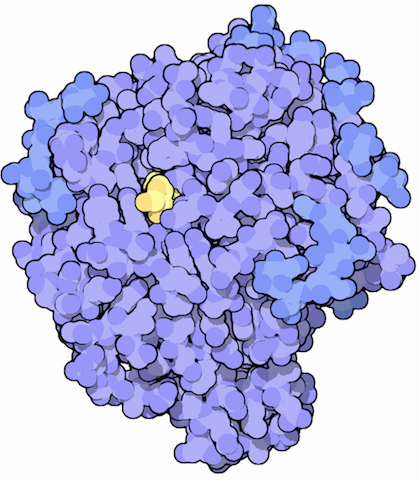Amyloglucosidase

Image source: Protein Data Bank.
AMG (also known as amyloglucosidase or glucoamylase) is an enzyme which removes glucose units from liquefied starch in a stepwise manner, producing glucose.
SOURCE
AMG is obtained from a selected strain of the fungus Aspergillus niger.
COMMERCIAL USES
AMG is used in the production of glucose syrups from starch or dextrins.
EDUCATIONAL USE
In an educational context, AMG can be used in place of conventional α-amylases (such as Termamyl®). It has the advantage that the enzyme will break down starch completely to glucose, so that the reaction can be monitored not just by the disappearance of starch (say with iodine/potassium iodide solution) but also by the appearence of glucose (using quanitative or qualitative methods). AMG is more heat-labile than Termamyl® but it still requires heating to 80 °C for about 5 minutes to denature it (but holding AMG at 60 °C for an hour will not denature it).
A graphic demonstration of AMG activity can be perfomed by adding a few drops of the enzyme to a tablespoonful of prepared instant mashed potato (such as ‘Smash‘). Within a few minutes, the mashed potato will be liquefied.
Please note that this enzyme preparation contains reducing sugars, and even when diluted 100-fold it will give a positive result with Benedict’s reagent.
ACTIVITY
The enzyme hydrolyses α-1,4 and branching α-1,6 linkages in liquefied starch. During hydrolysis, glucose units are removed in a stepwise manner from the non-reducing end of the substrate molecule. The rate of hydrolysis depends upon the type of linkage as well as the chain length, i.e., α-1,4 linkages are hydrolysed more readily than α-1,6 linkages, and maltotriose and maltose are broken down at a lesser rate than longer chain oligosaccharides. AMG has a pH optimum of about 4.0 and a temperature optimum of 75 °C. For more details, please consult the data sheet provided with the enzyme preparation.
STORAGE
The enzyme preparation should be stored at 3–5 °C. At this temperature the enzyme will maintain its declared activity for at least a year. At 25 °C, you can expect the enzyme to maintain its declared activity for at least 6 months. Do not freeze.
SAFETY

DANGER. May cause allergy or asthma symptoms or breathing difficulties if inhaled. See Safety Data Sheet for further advice.
SAFETY DATA SHEET
AMYLOGLUCOSIDASE
AMG ….. 100 mL ….. £21.00 (GBP)
ORDERING
All of the prices on this page are in GBP and do not include Value Added Tax (VAT). This tax applies within the European Union only. Postage and handling must also be paid on orders from outside the United Kingdom. Details of how to order are given on the price list and on the Ordering web page.
Please note: We are unable to supply this product to addresses in the United States of America.
PLEASE NOTE: THE NCBE SUPPLIES THESE ENZYMES TO SCHOOLS AND COLLEGES FOR EDUCATIONAL USE ONLY. COMMERCIAL USERS OF ENZYMES OR THOSE WHO REQUIRE ENZYMES FOR RESEARCH PURPOSES SHOULD CONTACT THE ENZYME MANUFACTURERS OR OTHER SUPPLIERS, NOT THE NCBE.

